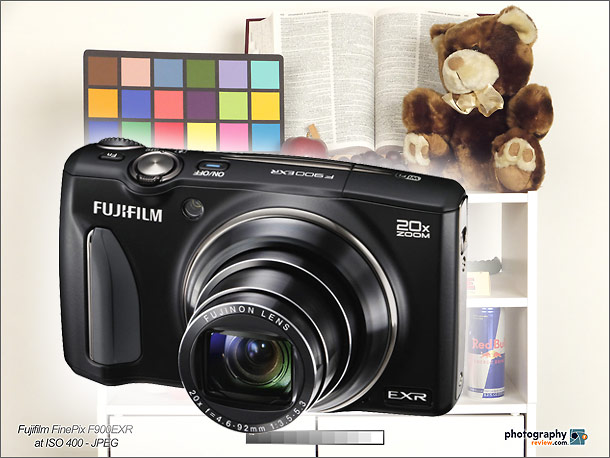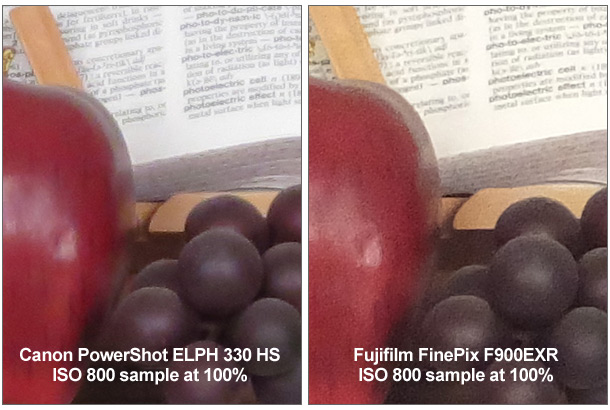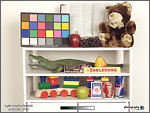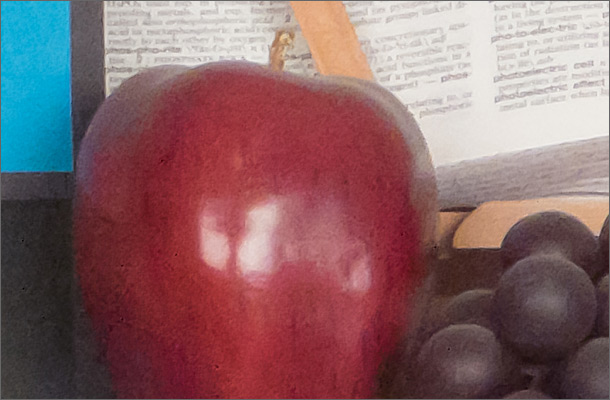I’ve been ogling the Fujifilm FinePix F900EXR from a distance for a while now (read my intro article). I love pocket superzoom cameras like the F900EXR because of their packability and versatility, but they all use standard 1/2.3-inch point-and-shoot sensors and only capture JPEGs. All of them except the Fujifilm F900EXR, that is. The F900EXR has a larger 1/2-inch sensor and it can shoot RAW as well as JPEG. The question is – do the larger sensor and RAW shooting add up to any real image quality difference? I’ve been wondering that for a long time and now that we’ve got the F900EXR in for review, I finally have some answers.
Update: Our complete review for the Fujifilm FinePix F900EXR pocket superzoom camera is live. Written by photographer Adam Lisonbee, a.k.a. Grizzly Adam, the review was written around a multi-day mountain bike race in the Colorado Rocky Mountains that Adam raced and photographed with the F900EXR:
Fujifilm FinePix F900EXR Review >>

Analyzing the F900EXR studio tests wasn’t as straightforward as most of the image quality analysis I do. Most of the time I’m comparing apples to apples – JPEGs to JPEGs, or RAW files to RAW files. But since every other pocket superzoom only shoots JPEG, I had to figure out how to compare the F900EXRs RAW files to JPEG Images. To make sure I covered all the bases, I shot RAW + JPEG for this test and you’ll find both sets of sample photos below.
Before we move on, I’m going to do a little background on the differences between RAW and JPEG images for those who may not know. JPEG images are processed in the camera. The camera determines what it thinks is the best white balance, contrast, sharpening and noise reduction and then locks those in. The end result is a compressed file with a lot less data than the sensor originally collected. A RAW image is just the untouched data off the sensor – all of it. With small sensor point-and-shoot cameras like the F900EXR, JPEG images processed in the camera really should look better than the RAW files. It’s the photographer’s job to process the RAW files and make them look good. RAW files have more potential. But it’s the photographer’s responsibility to make good use of that potential. Photographers who don’t want to do the extra work are better off sticking with JPEGs.
So how does the F900EXR compare to the competition? I compared to a recent Canon point-and-shoot – the PowerShot ELPH 330 HS. It uses the same sensor as Canon’s top-of-the-line pocket superzoom, the PowerShot SX280 HS; and I think it has about the best image quality of all the 1/2.3-inch sensor cameras on the market. Remember, we’re talking about JPEG image quality here. None of the other pocket superzooms shoot RAW. So to start, I compared the F900EXR JPEGs to the Canon samples. To even the playing field, I resized the Fujifilm F900EXR ISO 800 sample photo to the same resolution as the Canon image. The Canon JPEG samples definitely look better – even with the F900EXRs larger, higher-resolution sensor. The Canon’s tungsten white balance preset was clearly more accurate and the Fujifilm sample had more visible noise. Check out the 100% crop sample below to see for yourself:

However, with the F900EXR’s RAW files, you can apply as much or as little noise reduction as you want, tuning the image quality to your own taste. I was able to make my F900EXR tests look fairly comparable to the Canon samples when I processed the RAW files in Lightroom (click on the sample below to see the full image). The Canon image still retained a little better detail than I was able to get. On the other hand, my processed image doesn’t have that silky, over-processed look I think the Canon has. Another benefit of shooting RAW is white balance isn’t locked in like it is with JPEGs. When you shoot a RAW photo, it’s no problem at all to adjust the white balance after the fact – so fixing the color in the F900EXR tests wasn’t a problem, either. Also, since the RAW files contain more data – there’s more highlight and shadow information to work with when you’re processing photos. In the JPEG images from both cameras, the edge of the shelf is pure white with no detail and the shadows are very nearly pure black. But in the Fujifilm F900EXR’s RAW image there’s still detail left on the edge of the shelf and a lot more shadow detail. That means there’s more information for optimization when you’re processing the photos on the computer. More information is always good, but it’s especially valuable when you accidentally under or overexpose an important photo. You have a much better chance of making a bad photo useable if you shot it in RAW mode.
The bottom line is this – if you’re a true point-and-shoot photographer who just takes pictures and doesn’t care about post-processing, the F900EXR image quality isn’t any better than the competition. There doesn’t appear to be any real benefit from the F900EXR’s larger sensor – not for JPEG images, anyway. However, if you’re like me, and you prefer to shoot RAW and massage every image file to get the most out of it, then the F900EXR is definitely better. Don’t take my word for it, though. Check out the sample photos below and make your own decision. If you want to compare to the Canon samples I was talking about, you can find them, here.
These Fujifilm F900EXR studio test photos were taken in the PhotographyREVIEW.com studio at all ISO settings in both RAW and JPEG (there are two sets of test – JPEG, then RAW) – except for ISO 6400 and ISO 12,800, which the camera only captures as lower resolution JPEG images. The camera was set to aperture priority mode and white balance was set on the tungsten preset. The RAW files were converted to TIFFs in Lightroom and the text, graybar and logo were added in Photoshop before the images were resaved as maximum quality JPEGs. No sharpening, noise reduction or any kind of adjustments have been applied. Please feel free to download, compare and print as you see fit.
Warning: these files are big – be patient while they download.
Fujifilm F900EXR Studio JPEG Sample Photos
 Fujifilm FinePix F900EXR ISO 100 JPEG Sample |
 Fujifilm FinePix F900EXR ISO 200 JPEG Sample |
 Fujifilm FinePix F900EXR ISO 400 JPEG Sample |
![]()
 Fujifilm FinePix F900EXR ISO 800 JPEG Sample |
 Fujifilm FinePix F900EXR ISO 1600 JPEG Sample |
 Fujifilm FinePix F900EXR ISO 3200 JPEG Sample |
![]()
 Fujifilm FinePix F900EXR ISO 6400 JPEG Sample |
 Fujifilm FinePix F900EXR ISO 12,800 JPEG Sample |
![]()
Fujifilm F900EXR Studio RAW Sample Photos
The RAW files have been converted and resaved as maximum quality JPEGs to make it easier to view and share them.
 Fujifilm FinePix F900EXR ISO 100 RAW Sample |
 Fujifilm FinePix F900EXR ISO 200 RAW Sample |
 Fujifilm FinePix F900EXR ISO 400 RAW Sample |
![]()
 Fujifilm FinePix F900EXR ISO 800 RAW Sample |
 Fujifilm FinePix F900EXR ISO 1600 RAW Sample |
 Fujifilm FinePix F900EXR ISO 3200 RAW Sample |
![]()
We welcome your comments and user reviews. If you own the Fujifilm FinePix F900EXR, please click on the link below to go to the user review page and write your own review.
Fujifilm FinePix F900EXR Review >>
All Digital Camera Sample Photos >>
Related Content:
All Canon User Reviews
All Digital Camera User Reviews
Canon Cameras Forum
Digital Cameras Forum
Canon News, Reviews & Articles
Canon Web Site



Hi, nice review. I am buying either the fuji900exr or the canon sx280, looking at your examoles even in RAW mode I think canon jpg images look nicer however isnt the fuji better handling DR?
Glad you liked our F900EXR sample photos comparison, Leonardo. Good question, too. The answer is, yes – the F900EXR does have better dynamic range than the Canon – especially if you shoot RAW. If you don’t shoot RAW then the Canon might be a better choice. Because the F900EXR has RAW, you also have better color via adjustable white balance. For more serious photographers who are willing to spend a little time in Lightroom / Photoshop, the Fujfilm is definitely the better camera. But if you’re a true point-and-shoot photographers, it’s probably better to go with the Canon. By the way, we have a full review up for the F900EXR now. Here’s a link to that review:
http://www.photographyreview.com/reviews/fujifilm-finepix-f900exr-pocket-superzoom-camera-review
I hope that helps you make your decision